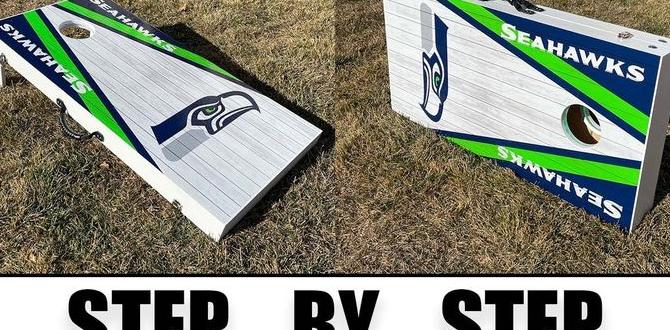Quick Summary:
Fixing inconsistent nail depth on your nail gun means adjusting pressure, checking your tool’s settings, and ensuring you’re using the right nails. Little tweaks can make a big difference in getting nails driven perfectly every time, saving you time and frustration on your DIY projects.
Hey folks, Jack Shaffer here from Nailerguy! Ever driven a nail only to have it stick out a bit too much, or sink way in and leave a nasty hole? It’s a common frustration when you’re working with a nail gun, and it can really slow down your projects. These aren’t just cosmetic issues; nails that are too proud can snag things, and nails driven too deep can weaken your materials.
But don’t worry! This little hiccup is usually easy to sort out. We’re going to dive deep into why this happens and, more importantly, how to fix it. We’ll cover everything from simple adjustments to common pitfalls to get your nail gun firing with precision.
By the end of this guide, you’ll know exactly how to tune your nailer for consistent, perfect drives. Let’s get those nails sinking just right!
Table of Contents
Why Nail Depth Matters (And Why It Gets Tricky)
Getting the nail depth right is crucial for a few reasons. When a nail is driven perfectly, it sits flush with or slightly below the surface. This creates a clean finish and ensures structural integrity. A nail that’s not driven deep enough can leave a sharp point exposed, creating a hazard and an unattractive look. Conversely, a nail driven too deep can split wood, especially near edges, and create an unsightly divot that’s difficult to repair.
So, why does this consistency challenge pop up? Several factors can contribute to this. It’s often a combination of how the nail gun is set up, the materials you’re working with, and even the nails themselves. Understanding these variables is the first step to mastering your nailer’s depth.
Common Culprits Behind Inconsistent Nail Depth
Before we jump into solutions, let’s identify the usual suspects. Recognizing these common issues will help you pinpoint the problem with your nail gun:
- Air Pressure/Power Settings: This is the biggest one! Too little pressure, and the nail won’t drive fully. Too much, and it’ll bury itself.
- Depth Adjustment Dial/Selector: Most nail guns have a setting to control how deep the nail is driven. If this isn’t set correctly, or if it’s bumped, you’ll get inconsistent results.
- Nail Gun Type and Specs: Different nail guns are designed for different tasks and materials. Using a framing nailer to put tiny brads into delicate trim will cause problems.
- Material Being Nailed: While you can’t change the wood, harder woods require more power than softer woods. A setting that’s perfect for pine might be too much for oak.
- Nail Size and Gauge: Thicker nails generally require more force to drive.
- Nail Gun Maintenance: A dirty or poorly maintained nail gun can behave erratically.
- Firing Mode (Sequential vs. Contact): While less about depth and more about how it fires, understanding these modes is part of proper operation.
- The Nose of the Nail Gun: If the contact tip is damaged or dirty, it might not sit flush against the surface.
Essential Tools and Supplies You’ll Need
Fortunately, fixing inconsistent nail depth usually doesn’t require a toolbox full of specialized gear. Here’s what you’ll likely need handy:
- Your Nail Gun: Of course!
- Air Compressor (if pneumatic): Ensure it’s working correctly and has a regulator.
- Air Hose: A good quality hose in the right length.
- Safety Glasses: Always, always, always!
- Gloves: For grip and protection.
- Owner’s Manual: This is your best friend for specific settings and maintenance.
- Screwdriver/Allen Wrench Set: For any minor adjustments or cleaning.
- Degreaser/Lubricant: For basic maintenance if needed.
- Scrap Wood: Perfect for testing your settings without ruining your project.
Step-by-Step Guide: How to Fix Inconsistent Nail Depth
Let’s roll up our sleeves and get this sorted. We’ll go through a logical process to diagnose and fix the problem. Remember to always wear your safety glasses and disconnect the air supply (if pneumatic) or battery (if cordless) before making any adjustments to the tool itself.
Step 1: Check and Adjust Air Pressure (Pneumatic Nailers)
This is the most frequent cause of inconsistent depth for pneumatic nail guns. The adjustable regulator on your air compressor is key.
- Connect Your Air: Hook up your air hose to the nail gun and compressor.
- Turn Up Pressure Gradually: Start with the recommended pressure for your nail gun, usually found in its manual. If you don’t have the manual, a good starting point for many common tasks is around 70-90 PSI (Pounds per Square Inch).
- Test Fire: Use a piece of scrap wood. Fire a few nails.
- Observe: Are they sinking too much or not enough?
- Adjust:
- Nails too shallow: Increase the air pressure by 5 PSI at a time on your compressor’s regulator. Test again. Repeat until satisfactory.
- Nails too deep: Decrease the air pressure by 5 PSI at a time. Test again. Repeat until satisfactory.
- Consistency is Key: Once you find a pressure setting that drives nails correctly on your scrap wood, try to replicate it. It might need slight adjustments depending on the wood density.
Pro Tip: Don’t just crank the pressure up. It can damage your tool and your work. Find the sweet spot. For a great overview of air pressure and its importance, check out resources from the Occupational Safety and Health Administration (OSHA) on compressed air safety.
Step 2: Use the Depth Adjustment Feature
Most modern nail guns come with a depth-of-drive adjustment mechanism. This is usually a dial or a small lever located near the nose of the gun.
- Locate the Adjustment: Consult your nail gun’s manual if you’re unsure. It’s often a rotating collar or a slider.
- Understand the Settings: Typically, turning the dial in one direction (e.g., counter-clockwise) will increase the depth (drive nails deeper), and turning it the other way (e.g., clockwise) will decrease the depth (drive nails shallower).
- Make Small Adjustments: Again, start by making very small turns. A quarter-turn or even an eighth-turn can make a noticeable difference.
- Test Fire: Fire a few nails into your scrap wood.
- Observe and Repeat:
- If nails are too proud: Adjust the dial to drive them deeper.
- If nails are sinking too deep: Adjust the dial to drive them shallower.
- Fine-Tune: Keep making small adjustments and testing until your nails are driven to the desired depth consistently.
Important Note: This adjustment works in conjunction with air pressure. If your air pressure is too low, the depth adjustment might not have enough range to compensate effectively.
Step 3: Inspect and Clean the Nose/Contact Tip
The part of the nail gun that presses against the wood (the nose or contact tip) needs to be clean and undamaged. Debris build-up or damage can affect how the gun sits against the material, leading to inconsistent drives.
- Disconnect Power: Ensure the nailer is not connected to air or has the battery removed.
- Examine the Tip: Look closely at the nose of the gun. Is there any sawdust, glue, or paint caked on? Is the metal tip bent, chipped, or worn down?
- Clean Thoroughly: Use a stiff brush, a damp cloth, or a soft rag to remove any debris. For stubborn grime, a bit of degreaser might be helpful, but always check your manual for recommended cleaning agents.
- Check for Damage: If the tip is significantly damaged, it might affect the gun’s ability to set the nail correctly. Minor cosmetic damage might be okay, but a bent nose can cause jams or inconsistent firing.
- Lubricate (If Recommended): Some nail guns require occasional lubrication in specific areas, often around the piston or the housing per the manual. Follow these recommendations.
A clean nose ensures the gun can make solid contact with the surface for each nail, promoting uniform depth. This is also a good time to familiarize yourself with your nailer’s safety contact element (the part that must be pressed to fire).
Step 4: Verify Nail Compatibility and Condition
Not all nails are created equal. Using the wrong type or size of nail, or even nails that aren’t in good condition, can cause depth issues.
- Check Your Nail Gun’s Specifications: Every nailer is designed for specific nail types, lengths, and gauges. Your owner’s manual is the definitive source for this information. Using nails that are too long, too thick, or of the wrong collation angle can wreak havoc.
- Use the Correct Gauge and Length: For example, a brad nailer is for thin, small nails (like 18-gauge brads), while a framing nailer handles much larger, thicker nails (like 2-inch to 3.5-inch framing nails). Trim nailers fall somewhere in between.
- Inspect the Nails: Are the nails straight? Are they bent or deformed before they go into the gun? Damaged nails can lead to jams and inconsistent penetration.
- Collation Check: Ensure the nails are properly loaded and seated in the magazine. The collation (the glue or plastic holding the nails together) should match what your nailer expects.
- Magazine Loading: Make sure the nails sit flush against the bottom of the magazine and are pushed forward correctly.
Using the correct, high-quality nails from a reputable manufacturer designed for your specific tool is paramount for predictable performance.
Step 5: Consider the Firing Mode and Technique
While depth is primarily controlled by pressure and the adjustment dial, how you use the nailer can also play a role, especially with certain modes.
- Sequential (Single-Fire) Mode: In this mode, you must pull the trigger and press the nose of the gun against the wood for each nail. This offers the most control. If you’re getting inconsistent depth here, it’s likely still an air pressure or depth adjustment issue.
- Contact (Bump) Fire Mode: In this mode, you hold the trigger down and rapidly press the nose of the gun against the surface to fire nails. This is faster but offers less precise depth control if not handled correctly.
- Technique Matters: When bump firing, try to apply consistent pressure with the nose of the gun each time. Too little pressure can lead to a shallow shot, while a hard jab might drive it too deep or even recoil the gun slightly.
- Don’t Slam: Avoid slamming the gun against the wood. A firm, consistent press is better.
- Nail Gun Angle: Always try to fire the nail gun perpendicular to the surface. Driving it at an angle can cause the nail to sink unevenly or not all the way.
- Tool Stability: Ensure the tool is stable against the surface before firing. If the gun is wobbly or you’re firing too quickly, you might not be getting a consistent set.
For a detailed look at different nail gun modes and how to use them effectively, you can explore guides from reputable woodworking resources like Woodworkers Journal.
Step 6: Address Material Density and Wood Type
The material you’re fastening is a significant factor in how nails penetrate. Softer woods compress easier, while hardwoods are much denser.
- Hardwoods vs. Softwoods: If you’ve set your nailer perfectly for pine (a softwood) and then switch to oak (a hardwood), you’ll likely find your nails aren’t sinking enough.
- Edge and End Grain: Nailing near the edge or end of a board is trickier. The wood fibers are weaker there and more prone to splitting, and nails can also blow out the side or not penetrate fully.
- Engineered Wood and MDF: Materials like plywood, MDF, and particle board have different densities and consistencies than solid wood. You may need to adjust your settings for these.
- Adjusting for Density:
- For Harder Materials: You might need to slightly increase air pressure or adjust the depth dial to drive nails deeper.
- For Softer Materials: You might need to decrease air pressure or adjust the depth dial to avoid over-driving.
- For Edges/Ends: Nailing carefully, reducing pressure slightly, or even pre-drilling a pilot hole (though that defeats the speed of a nailer) can help prevent blow-outs and improve depth.
- Test, Test, Test: Always test your settings on a piece of the exact same material you’ll be working with.
Understanding your material is a key part of mastering your nailer.
Step 7: Advanced Troubleshooting and Maintenance
If you’ve gone through the steps above and are still experiencing inconsistent depth, it might be time for a deeper dive into maintenance or a more specific issue.
- Check the O-Rings and Seals: Over time, rubber O-rings and seals within the nail gun can wear out or become damaged. This can lead to air leaks and inconsistent power delivery. Refer to your manual for instructions on checking and replacing these.
- Internal Mechanism: A jammed nail from previously, or a part that’s not seating correctly internally, can affect the firing mechanism. If you suspect this, a more thorough disassembly might be needed, or it might be time to take it to a professional for repair.
- Battery Check (Cordless Nailers): For cordless models, ensure your battery is fully charged. A low battery can lead to reduced power output. Also, inspect battery contacts for corrosion.
- Is the Nail Gun Defective? In rare cases, there might be a manufacturing defect or a component failure within the nailer itself.
Regular, preventative maintenance is your best defense against these kinds of issues. For robust advice on tool maintenance, the Tooling-Up.com website offers excellent, though detailed, articles on tool care.
Troubleshooting Table: Common Issues and Solutions
Here’s a quick reference table to help you diagnose and fix inconsistent nail depth issues on your nail gun:
| Problem | Possible Cause(s) | Solution(s) |
|---|---|---|
| Nails are driven too shallow (sticking out) | Low air pressure (pneumatic) | Increase air pressure gradually. |
| Depth adjustment set too shallow | Turn depth adjustment dial to increase depth. | |
| Insufficient battery power (cordless) | Recharge or replace battery. | |
| Wrong nail collation/size | Verify nail compatibility with gun. | |
| Nails are driven too deep (sinking too far, splitting wood) | Excessive air pressure (pneumatic) | Decrease air pressure gradually. |
| Depth adjustment set too deep | Turn depth adjustment dial to decrease depth. | |
| Nailing into very soft material | Slightly reduce air pressure or depth setting. | |
| Overly aggressive bump firing | Use a lighter touch when pressing the nose. | |
| Inconsistent depth (sometimes too deep, sometimes too shallow) | Fluctuating air pressure / faulty regulator | Check and service air compressor regulator. |



